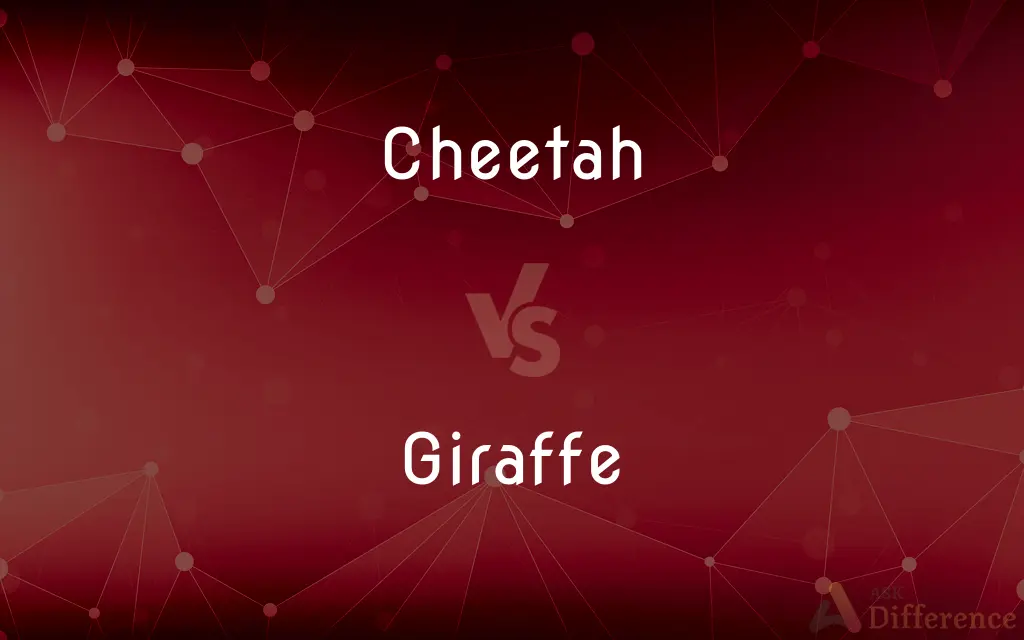Cheetah vs. Giraffe — What's the Difference?
By Fiza Rafique & Urooj Arif — Updated on March 14, 2024
Cheetahs are the fastest land animals, renowned for their speed and agility in hunting, while giraffes are the tallest mammals, known for their long necks and legs, adapted for browsing foliage high above the ground.

Difference Between Cheetah and Giraffe
Table of Contents
ADVERTISEMENT
Key Differences
Cheetahs, belonging to the family Felidae, are distinct for their slender bodies, deep chests, and incredible speed, capable of reaching up to 70 miles per hour in short bursts covering distances up to 1,500 feet. They have a unique black tear-stripe that runs from the inner corner of each eye to the mouth, which helps protect against the sun's glare during hunts. On the other hand, giraffes, members of the family Giraffidae, stand out for their long necks, which can be up to 6 feet in length, and long legs, allowing them to reach leaves and twigs on trees up to 18 feet off the ground. Their height can be as much as 18 feet, making them the tallest land animals.
The cheetah's diet mainly consists of smaller hoofed animals, such as gazelles and impalas, relying on their speed to catch prey. Conversely, giraffes are herbivores, feeding on a variety of plants and leaves, particularly from acacia trees, which they can reach due to their height. Their long tongues, which can be up to 20 inches, help them navigate around thorns in the trees they feed from.
Cheetahs use their exceptional speed and agility to hunt during the day, whereas giraffes spend much of their time eating, needing to consume up to 75 pounds of foliage daily to sustain their large bodies. This dietary habit makes giraffes prone to spend a significant amount of time exposed to predators.
Reproduction and lifespan also differ significantly between the two species. Cheetahs have a gestation period of around 90 to 95 days, giving birth to litters of three to five cubs. In contrast, giraffes have a much longer gestation period of about 15 months, typically giving birth to a single calf.
Both species face threats from habitat loss and poaching. Cheetahs are classified as vulnerable due to their declining population, with fewer than 7,000 individuals left in the wild. Giraffes have been experiencing a silent extinction, with some subspecies being listed as critically endangered, primarily due to habitat destruction, poaching, and disease.
ADVERTISEMENT
Comparison Chart
Family
Felidae
Giraffidae
Distinctive Features
Slender body, deep chest, black tear-stripes
Long neck and legs, tall stature
Speed/Height
Up to 70 mph
Up to 18 feet tall
Diet
Carnivore (gazelles, impalas)
Herbivore (leaves, twigs from tall trees)
Hunting/Feeding Behavior
Daytime hunters, rely on speed and agility
Consume up to 75 pounds of foliage daily
Gestation Period
90-95 days
15 months
Offspring
3-5 cubs per litter
1 calf
Conservation Status
Vulnerable
Ranges from vulnerable to critically endangered
Compare with Definitions
Cheetah
A carnivorous predator specializing in small to medium-sized ungulates.
Cheetahs primarily hunt gazelles and impalas by sprinting at high speeds.
Giraffe
The tallest mammal on Earth, with necks up to 6 feet long.
The giraffe could easily reach the highest leaves on the acacia tree.
Cheetah
Faces threats from habitat loss and is classified as vulnerable.
Conservation efforts are crucial to prevent the decline of the cheetah population.
Giraffe
Known for their long legs and distinctive coat patterns.
Each giraffe has a unique coat pattern that helps camouflage them in the wild.
Cheetah
Known for its slender body and distinctive black tear-stripes.
The cheetah's black tear-stripes help reduce glare, aiding in daytime hunting.
Giraffe
Herbivores that consume a variety of foliage, especially from acacia trees.
Giraffes spend most of their day eating to sustain their large bodies.
Cheetah
The world's fastest land animal, reaching speeds of up to 70 mph.
The cheetah outran every animal in the savannah during the chase.
Giraffe
Giraffes have a gestation period of about 15 months, usually birthing one calf.
The newborn giraffe calf stood up and walked within an hour of its birth.
Cheetah
Cheetahs have a unique social structure, often solitary or in small family groups.
Female cheetahs tend to live and hunt alone, except when raising cubs.
Giraffe
Vulnerable to extinction in some areas due to habitat loss and poaching.
Protecting giraffe habitats is essential for their survival.
Cheetah
The cheetah (Acinonyx jubatus) is a large cat native to Africa and central Iran. It is the fastest land animal, estimated to be capable of running at 80 to 128 km/h (50 to 80 mph) with the fastest reliably recorded speeds being 93 and 98 km/h (58 and 61 mph), and as such has several adaptations for speed, including a light build, long thin legs and a long tail.
Giraffe
The giraffe (Giraffa) is an African artiodactyl mammal, the tallest living terrestrial animal and the largest ruminant. It is traditionally considered to be one species, Giraffa camelopardalis, with nine subspecies.
Cheetah
A long-legged, swift-running wild cat (Acinonyx jubatus) of Africa and southwest Asia, having tawny, black-spotted fur and nonretractile claws. The cheetah, the fastest animal on land, can run for short distances at about 96 kilometers (60 miles) per hour.
Giraffe
A large African mammal with a very long neck and forelegs, having a coat patterned with brown patches separated by lighter lines. It is the tallest living animal.
Cheetah
A distinctive member (Acinonyx jubatus) of the cat family, slightly smaller than the leopard, but with proportionately longer limbs and a smaller head; native to Africa and southeast Asia (where it is nearly extinct) and also credited with being the fastest terrestrial animal.
Giraffe
An African ruminant mammal (Giraffa camelopardalis) having a very long neck and legs, a tan coat with orange-brown to black blotches, and short horns. It is the tallest land animal, often reaching a height of 5 meters (16 feet).
Cheetah
A species of leopard (Cynælurus jubatus) tamed and used for hunting in India. The woolly cheetah of South Africa is Cynælurus laneus. It runs very fast in short spurts while hunting.
Giraffe
A ruminant, of the genus Giraffa, of the African savannah with long legs and highly elongated neck, which make it the tallest living animal; yellow fur patterned with dark spots, often in the form of a network; and two or more short, skin-covered horns, so-called; strictly speaking the horn-like projections are ossicones.
Cheetah
Long-legged spotted cat of Africa and southwestern Asia having nonretractile claws; the swiftest mammal; can be trained to run down game
Giraffe
A giraffe unicycle.
Giraffe
(Cockney rhyming slang) A laugh.
Are you having a giraffe?!
Giraffe
A very tall individual.
Giraffe
An African ruminant (Giraffa camelopardalis formerly Camelopardalis giraffa) related to the deers and antelopes, but placed in a family (Giraffidae) by itself; the camelopard. It is the tallest of quadriped animals, being sometimes twenty feet from the hoofs to the top of the head. Its neck is very long, and its fore legs are much longer than its hind legs. There are three types, having different patterns of spots on the pelt and different territories: the Reticulated Giraffe, the Masai Giraffe, and the Uganda Giraffe. Intermediate crosses are also observed.
Giraffe
Tallest living quadruped; having a spotted coat and small horns and very long neck and legs; of savannahs of tropical Africa
Common Curiosities
How much food does a giraffe need to eat in a day?
A giraffe needs to consume up to 75 pounds of foliage daily to sustain its large body.
How tall can a giraffe get?
Giraffes can reach heights of up to 18 feet, making them the tallest mammals on Earth.
How do giraffes sleep?
Giraffes sleep standing up or lying down in short naps that total only a few hours a day, as their size and posture make them vulnerable to predators.
Why do cheetahs have tear stripes?
Cheetahs have tear stripes that run from the inner corners of their eyes to their mouths, which help reduce glare from the sun and improve their focus on prey during hunts.
Are cheetahs solitary animals?
Yes, cheetahs are typically solitary animals, especially young females, although some males may form small groups called coalitions.
What challenges do cheetahs face in the wild?
Cheetahs face several challenges, including habitat loss, conflicts with humans, poaching, and competition with other predators for food.
Can giraffes swim?
Giraffes are not known to swim and avoid large bodies of water because their long legs and necks make swimming difficult and energetically inefficient.
How do cheetahs hunt?
Cheetahs hunt primarily during the day, using their exceptional speed and agility to chase down and overpower their prey in short bursts.
What is the gestation period of a cheetah?
The gestation period of a cheetah is approximately 90 to 95 days.
What role do giraffes play in their ecosystem?
Giraffes play a crucial role in their ecosystem by acting as pollinators and seed dispersers for many tree species, especially acacias, helping maintain the health and diversity of their habitat.
Share Your Discovery

Previous Comparison
Fought vs. Fight
Next Comparison
Often vs. FrequentlyAuthor Spotlight
Written by
Fiza RafiqueFiza Rafique is a skilled content writer at AskDifference.com, where she meticulously refines and enhances written pieces. Drawing from her vast editorial expertise, Fiza ensures clarity, accuracy, and precision in every article. Passionate about language, she continually seeks to elevate the quality of content for readers worldwide.
Co-written by
Urooj ArifUrooj is a skilled content writer at Ask Difference, known for her exceptional ability to simplify complex topics into engaging and informative content. With a passion for research and a flair for clear, concise writing, she consistently delivers articles that resonate with our diverse audience.














































